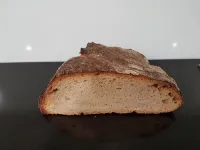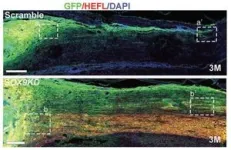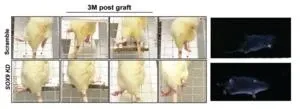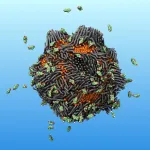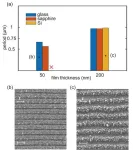(Press-News.org) SAN FRANCISCO, Aug. 16, 2023 — A few years ago, amid lockdown boredom, it seemed like everyone was perfecting their sourdoughs. A simple, fermented mixture of flour and water, the bread is powered by microbes that provide its one-of-a-kind tangy flavor. For over a hundred years, sourdough bread has been synonymous with San Francisco, where today, scientists will report that they’ve identified and quantified 21 key chemical compounds that make this bread taste and smell so unique. They’ve also compared the levels of the compounds in different breads.
The researchers will present their results at the fall meeting of the American Chemical Society (ACS). ACS Fall 2023 is a hybrid meeting being held virtually and in-person Aug. 13–17, and features about 12,000 presentations on a wide range of science topics.
Sourdough breads have existed for centuries, dating back to ancient Egypt — well before they hit their recent peak of popularity in 2020. Unlike other wheat or white breads, which often rely on baker’s yeast to rise, sourdough breads use a “starter” — a living colony of bacteria and wild yeast that causes the bread’s dough to rise through fermentation. Since the microbes come from the air of the local environment, certain places are reportedly home to the best loaves. For example, San Francisco’s unique foggy climate is said to help make its sourdoughs so famously delicious.
Even though these breads are common, little work has been done to understand what chemical compounds provide their characteristic taste and smell. This knowledge could be important to bakers who need to control the quality of their breads, preventing them from becoming too sour, and it could also help them create more consistent sourdoughs for consumers to enjoy. So, Thomas Hofmann’s team at the Technical University of Munich wanted to apply an updated version of a technique known as “sensomics” to sourdough bread crumb — the soft inside part of a loaf. Hofmann currently serves as editor-in-chief of ACS’ Journal of Agricultural and Food Chemistry.
“With sensomics, you can take just a few key compounds and completely recreate the characteristic taste of a food,” says Laura Eckrich, a graduate student in Hofmann’s lab, who is presenting the work at the meeting. The approach involves chromatography, mass spectrometry and similar methods. The team has applied the method previously to other foods to isolate all the flavor-active compounds and to determine their structures and concentrations, as well as how they contribute to taste. The team has used this knowledge to re-engineer the flavor profile of various foods from the bottom up.
Hofmann’s team isolated, identified and quantified the flavor compounds in sourdough bread crumb, and then determined which ones were the most important. The resulting 10 key “tastants” and 11 key “odorants” were then combined into a sourdough “essence,” the flavor of which was confirmed by a human sensory panel. The key taste compounds include salt, which is directly added to the dough, as well as acetic and lactic acid, produced during fermentation. After these experiments, they applied a technique called “unified flavor quantitation,” which was previously developed by Hofmann’s team, to the sourdough bread. For the first time, this technique allowed them to analyze these unique taste and aroma compounds simultaneously.
The team then used the method in brand-new studies to quantify the concentrations of these compounds in different types of bread. They collected both yeast-based and sourdough breads from local bakeries and supermarkets made with either rye or wheat flours. Though key sourdough compounds, including lactic and acetic acids, were found in the yeast-based breads, they were present in much smaller amounts. These results confirmed the importance of the fermentation process to the sourdough’s special flavor.
Next on the researchers’ plates was an analysis of the best way to reduce the salt content in breads. They addressed this issue by unevenly distributing saltier doughs throughout a dough mixture. Since breads, especially sourdoughs, can contribute significantly to one's daily salt intake, the method could help reduce the amount of sodium while maintaining the bread’s unique taste.
Ultimately, the team says their discoveries should be welcome news for the baking industry. “This was the first time the key taste and aroma compounds of bread crumb were elucidated using the sensomics approach, and we hope what we learned will help bakers create the best sourdough breads they can,” says Eckrich.
The researchers acknowledge support and funding from the German Research Foundation.
A recorded media briefing on this topic will be posted Wednesday, Aug. 16, by 10 a.m. Eastern time at www.acs.org/acsfall2023briefings. Reporters can request access to media briefings during the embargo period by contacting newsroom@acs.org.
For health and safety information for ACS Fall 2023, please visit the FAQ webpage.
The American Chemical Society (ACS) is a nonprofit organization chartered by the U.S. Congress. ACS’ mission is to advance the broader chemistry enterprise and its practitioners for the benefit of Earth and all its people. The Society is a global leader in promoting excellence in science education and providing access to chemistry-related information and research through its multiple research solutions, peer-reviewed journals, scientific conferences, eBooks and weekly news periodical Chemical & Engineering News. ACS journals are among the most cited, most trusted and most read within the scientific literature; however, ACS itself does not conduct chemical research. As a leader in scientific information solutions, its CAS division partners with global innovators to accelerate breakthroughs by curating, connecting and analyzing the world’s scientific knowledge. ACS’ main offices are in Washington, D.C., and Columbus, Ohio.
To automatically receive press releases from the American Chemical Society, contact newsroom@acs.org.
Note to journalists: Please report that this research was presented at a meeting of the American Chemical Society.
Follow us: Twitter | Facebook | LinkedIn | Instagram
Title
Flavor elucidation and simultaneous quantitation of key tastants and odorants of sourdough bread crumb
Abstract
Sourdough bread is highly appreciated for its unique taste and aroma. As a scientific basis, it is essential to identify the key compounds that contribute significantly to the flavor of bread crumb in order to investigate the influence of different ingredients and production parameters. By means of the sensomics approach, ten tastants and eleven odorants were identified as the key flavor compounds of sourdough bread crumb and verified by recombination and omission experiments. Based on this, a sensitive, high-throughput ultra-high-performance liquid chromatography-tandem mass spectrometry (UHPLC-MS/MS) method using stable isotope dilution analysis (SIDA) was developed, validated, and applied. By derivatization with 3-nitrophenylhydrazine (3-NPH), this method allows the simultaneous quantification of both non-volatile key tastants as well as volatile key odorants in bread crumb. The knowledge obtained about the key taste and aroma compounds and the quantitation method can be utilized to control and optimize the flavor of bread and to acquire objective and independent information about the flavor quality of breads.
END
What makes those pandemic-era sourdoughs so deliciously, uniquely, sour?
2023-08-16
ELSE PRESS RELEASES FROM THIS DATE:
Cleaning water with ‘smart rust’ and magnets (video)
2023-08-16
SAN FRANCISCO, Aug. 16, 2023 — Pouring flecks of rust into water usually makes it dirtier. But researchers have developed special iron oxide nanoparticles they call “smart rust” that actually makes it cleaner. Smart rust can attract many substances, including oil, nano- and microplastics, as well as the herbicide glyphosate, depending on the particles’ coating. And because the nanoparticles are magnetic, they can easily be removed from water with a magnet along with the pollutants. Now, the team is reporting that they’ve ...
Tubing and swimming change the chemistry and microbiome of streams
2023-08-16
SAN FRANCISCO, Aug. 16, 2023 — With Labor Day approaching, many people are preparing to go tubing and swimming at local streams and rivers. These delightful summertime activities seem innocuous, but do they have an impact on these waterways? Today, scientists report preliminary results from the first holistic study of this question, which shows that recreation can alter the chemical and microbial fingerprint of streams, but the environmental and health ramifications are not yet known.
The researchers will present their results at the fall meeting of the American Chemical Society (ACS). ACS Fall 2023 is a hybrid meeting ...
Experiencing pain after a heart attack may predict long-term survival
2023-08-16
Research Highlights:
Experiencing pain – even pain not associated with heart disease – a year after having a heart attack is common, and people who had moderate or extreme pain were more likely to die within the next 8 years compared to adults who did not have any post-heart attack pain.
When recommending treatment and making prognoses for people who have had a heart attack, health care professionals should consider if the patients are experiencing moderate or extreme pain.
Embargoed until 4 a.m. CT/5 a.m. ET Wednesday, Aug. 16, 2023
DALLAS, ...
Racism, poverty, and illiteracy increase the risk of contracting and succumbing to AIDS in Brazil
2023-08-16
Social determinants of health —the social conditions in which people grow up, live and work— can influence the risk of contracting AIDS and the mortality associated with the disease. This is the main conclusion of a new study carried out by the Barcelona Institute for Global Health (ISGlobal), a centre supported by the "la Caixa" Foundation, and published in The Lancet Regional Health.
The research team evaluated a cohort of 28.3 million people, representative of the low-income Brazilian population, based on data collected between 2007 and 2015. This is the largest evaluation of social determinants of health ...
Harnessing big data reveals birds’ coexisting tactics
2023-08-16
Birds likely hold smart insights about coexisting in popular habitats– especially as climate change looms. But tapping into that knowledge has a big hurdle: knowing where and how numerous birds live successfully in vast environments.
In today’s biological research journal Proceedings of the Royal Society B, scientists at Michigan State University (MSU) peeled back layer upon layer of big data to tease out real-life answers that until now have been explored mostly in small-scale experiments.
Sam Ayebare, a PhD candidate from Uganda, has led the work that is the first steps to understanding how so many birds can coexist in the vast Albertine ...
Six strategies could boost NY City housing by 300,000 units over decade
2023-08-16
Six policies aimed boosting residential housing construction in New York City could spark the production of roughly 300,000 additional new housing units over a decade, according to a new RAND Corporation report.
The additional housing units would represent more than a 160% increase over recent annual housing production levels in the city, according to the report.
Researchers say the surge in housing supply likely would lead to increased affordability through greater competition among landlords for tenants in the short term and an increase in naturally occurring ...
The Journal of Scientific Exploration publishes special issue on the Shakespeare authorship question
2023-08-16
In the issue, ten historians and literary scholars present evidence that casts serious doubts about who actually authored the monumental works credited to William Shakespeare. Suggesting that the name is actually a pseudonym for someone else, this position has been endorsed by numerous artists and scholars over the decades ranging from Walt Whitman and Mark Twain to Sigmund Freud, Tyrone Guthrie (founder of Canada’s Stratford Shakespeare Festival) and Mark Rylance founding Artistic Director of the reconstructed Globe Theatre in London.
Tradition credits a businessman from an essentially ...
In-school occupational therapy creates positive education experiences for kids with autism
2023-08-16
Strong parent-school relationships are central to a child’s learning, development, and wellbeing, yet when it comes to children with autism (ASD), it seems positive relationships are few and far between say UniSA researchers.
In Australia, an estimated 200,000 people are autistic, with autism the largest primary disability group served by the NDIS. Globally, about one in 100 children are autistic.
Lead researcher, UniSA’s Dr Kobie Boshoff, says support is urgently needed in schools to support the learning needs of children with ...
Team compares reanalysis datasets with Advanced Himawari Imager measurements over East Asia
2023-08-16
Today’s weather satellites provide scientists with a unique opportunity to evaluate the abilities of various reanalysis datasets to depict multilayer tropospheric water vapor. So a research team undertook a study to assess multilayer water vapor depiction in six representative reanalysis datasets against the measurements from the Advanced Himawari Imager over East Asia. Because water vapor is important in the formation of clouds and precipitation, it is vital for scientists to better understand water vapor and the biases among various datasets.
Their work is published in the journal Advances in Atmospheric Science on July 29, 2023.
Scientists produce reanalysis datasets when ...
Controlling the source of electromagnetic waves enables control of the period of laser-induced periodic surface structures (LIPSS)
2023-08-16
Since the scientists at Bell Labs invented the world’s first transistor in December 1947, a revolution in microelectronics technology has profoundly affected lifestyles worldwide. As electronics get smaller and smaller, it is a challenge to find an easy, fast, and low-cost way to fabricate micro-nano components. Traditional direct writing fabrication methods such as mechanical scribing, focused ion beam etching, electron beam lithography, multiphoton polymerization, and thermal scanning probe etching are inefficient. Although methods such as nanoimprinting, photolithography, plasma etching, and ...
